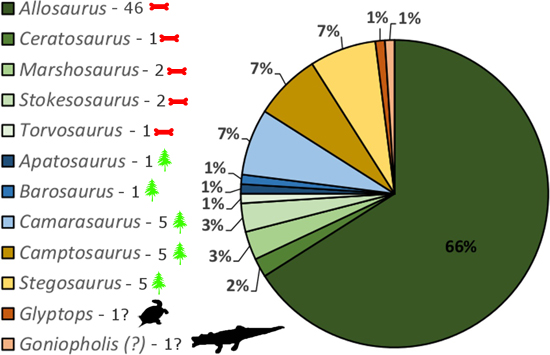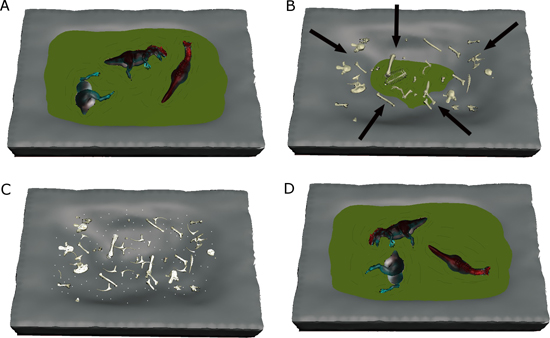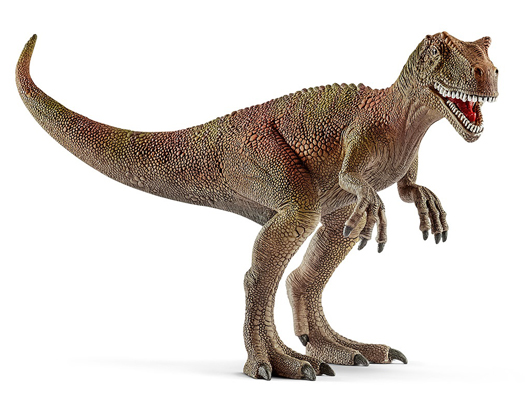Has the Cleveland-Lloyd Dinosaur Quarry Mystery Been Solved?
One of the most prolific dinosaur fossil sites to be found anywhere in the world lies thirty miles to the south of the town of Price in Utah. The site is close to the small community of Cleveland (Emery County) and some 15,000 dinosaur bones have been collected from this site to date. The strata represent Upper Jurassic siltstone (Brushy Basin member of the Morrison Formation) and this location is the densest collection of Jurassic dinosaur fossils known to science.
Jurassic Dinosaur Fossils
Since the first excavations were carried out in the late 1920s, palaeontologists have been puzzled by the assemblage of vertebrate fossils they found. Although, carnivorous dinosaurs were probably less common in the palaeoenvironment than the plant-eaters, at this site, the fossils of theropods (carnivores) outnumbers the fossils of herbivorous dinosaurs by almost three to one. In addition, the most common dinosaur fossil material is Allosaurus, the bones of this large dinosaur are extremely numerous at least forty-six individuals (based on femur bone counts) are recorded.
A Mounted Skeleton of the Late Jurassic Carnivore Allosaurus
Picture credit: Everything Dinosaur
The picture (above) shows a Papo Allosaurus model.
To view the Papo model range: Papo Dinosaur and Prehistoric Animal Figures.
For nearly one hundred years, palaeontologists have puzzled over this unique fossil assemblage. Why is this particular location so full of the bones of carnivorous dinosaurs? Why are the vast majority of these bones from a single genus – Allosaurus?
A Pie Chart Showing the Proportion of Different Dinosaur Fossils from the Cleveland-Lloyd Quarry
Picture credit: PeerJ with additional annotation by Everything Dinosaur
The pie chart above lists dinosaur fauna plus one turtle (Glyptops) and a crocodyliform (Goniopholis) from the Cleveland-Lloyd Dinosaur Quarry. The bone symbol identifies meat-eating dinosaurs and the fir tree, plant-eating dinosaurs. The fossils of Allosaurus dominate the bonebed.
Theories Explaining the Cleveland-Lloyd Dinosaur Quarry Bonebed
Several theories have been suggested as to what caused the build-up of dinosaur fossils at this location and why the majority of them represent one carnivorous genus.
- This was a predator trap. A pond attracted dinosaurs to the site as it was a source of water in the dry season. These animals got stuck in the mud and they died, this in turn attracted scavengers who also become stuck and perished.
- This site could mark a mass death assemblage of a lot of dinosaurs which died in a drought.
- Was the water source toxic and this poisoned a lot of dinosaurs? The rotting corpses attracted scavengers and these too were poisoned.
Writing in the academic journal “PeerJ” a team of researchers have put forward a new theory to explain the unusual taphonomy (the process of fossilisation). The use of modern data techniques suggests that the quarry represents a series of catastrophic events that occurred at the same place over time, rather than a single mass death assemblage.
A New Theory
The research team, which included lead author Joseph Peterson (University of Wisconsin-Oshkosh), conclude that the myriad of small bone fragments found at the site, were created during periods of drought as bones which were not buried were weathered and eroded away on the surface. Dinosaur carcasses were washed into the site which represented a temporary (seasonal or ephemeral pond) during frequent flood events. As the corpses decayed, they led to very high levels of minerals and organic material in the water (hypereutrophic conditions). This discouraged scavenging (which explains the lack of gnaw marks and other evidence of scavenging by predators at the site).
As more flood events took place, so more corpses were washed into the area and the existing skeletons were re-deposited. Hence the jumble of bones. The hypereutrophic water created an environment in which fish, turtles and crocodiles could survive and carnivorous dinosaurs were dissuaded from eating the carcasses. Only a handful of crocodyliform teeth have been found at the Cleveland-Lloyd site, along with some turtle shell fragments, whereas, elsewhere in the Morrison Formation, turtle and crocodyliform teeth are much more numerous.
Explaining the Unusual Bonebed at the Cleveland-Lloyd Quarry Site
Picture credit: PeerJ
The image above reflects the newly proposed theory as to how the Cleveland-Lloyd Dinosaur Quarry formed.
(A) A flood causes the carcasses of dinosaurs to be deposited in the quarry area. High levels of organic matter decaying leads to hypereutrophy (an excess of minerals in the water source). This discourages predators from scavenging and deters freshwater fauna such as fish, turtles and crocodile-like creatures.
(B) As water levels fall during the dry season, bones that were not buried during the flood stage remain exposed on the surface.
(C) In arid conditions the surface bones are subjected to weathering and erosion.
(D) A subsequent flood event leads to more carcasses being incorporated and the reworking of existing bones within the deposit.
The scientists conclude that this cycle was repeated until the deposit maintained a higher water table, producing the limestone layers above the bone-bearing silts and muds.
A Model of the Fearsome Late Jurassic Predator Allosaurus (A. fragilis)
To view the Schleich dinosaur model range: Schleich Dinosaur and Prehistoric Animal Figures.
The picture (above) shows a Schleich Allosaurus model, one of an extensive range of Schleich dinosaurs.
Visit the Everything Dinosaur website: Everything Dinosaur.










Is the Apatosaurus species in Cleveland Lloyd Quarry Apatosaurus ajax or simply an Apatosaurus sp.?
We don’t know for sure, if you email the resident on site palaeontologist I am sure they will provide further information. Our guess would be Apatosaurus spp as many of the bones remain in the rocks around the park and have not been excavated or described.